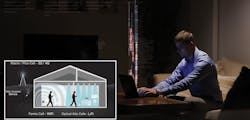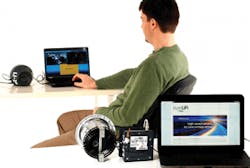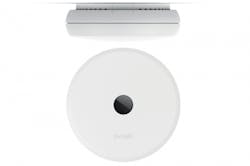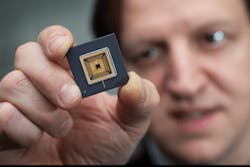The Future of Wireless Is LiFi
It’s impossible to avoid WiFi in today’s world. It’s everywhere; your neighbours have it, it’s free in coffee shops, and essential for mobile Internet via smartphones. We all know WiFi, but what is LiFi?
Secure, localized, safe and incredibly fast, LiFi is here and set to increasingly shape our working and domestic lives in the future, because we will be running out of radio frequency spectrum.1
The Li-1st offers a highly effective tool for developing initial LiFi applications, enabling full duplex, high bandwidth point-to-point communication with a ceiling unit (CU) as an LED driver to create a LiFi access point (AP) and a desktop unit (DU) as a laptop attachment for uplink communication.
LiFi, like WiFi, enables electronic devices like computers, laptops and smartphones to wirelessly connect to the Internet. Even though WiFi was also originally intended for such devices, it is widely used today to connect all sorts of things: printers, televisions, speakers, headphones, and even running shoes! In simple terms, LiFi is equivalent to WiFi, but uses light waves instead of radio signals.
LiFi uses the light waves from LED light bulbs — that are rapidly replacing incandescent light bulbs for their energy savings and durability — to transmit data so it provides illumination and wireless data communications at the same time and with the same device.
Wherever there is an LED light, there is the potential with LiFi to access the Internet at incredibly fast speeds in a safe and secure manner.
How Does It Work?
LiFi, a term first coined by Prof. Harald Haas at his TED Global talk in 2011 (www.bit.ly/tedvlc), is a disruptive technology that delivers high speed, bidirectional and networked wireless communications, similar to WiFi, except using light. This is also the official definition according to the IEEE 802.15.7r1 committee that is defining the standard for Optical Wireless Communications.2
Standard LED light bulbs are controlled by a driver-circuit that turns the LED on and off, or dims and brightens it. With LiFi-enabled LED light bulbs, the ordinary driver-circuit is replaced with a LiFi driver-circuit used to transmit encoded data by controlling the intensity of the LED light. An optical sensor is used to receive the data, which is then decoded. This is conceptually similar to Morse code — but at rates of many millions of times a second, which are unnoticeable by the human eye.
The transmission speeds can be over 100 Gbps with current technology and using the visible light spectrum, but this requires special LEDs.3 This is 14 times faster than the fastest WiFi, referred to as WiGig. With current commercial and inexpensive, phosphorous coated white LEDs it is possible to achieve about 100 Mbps on a single link. However, LiFi describes a fully-fledged wireless network with multiple transceivers (just imagine how many lights are in a typical room). The network capacity of a LiFi network with commercial LEDs can be 3 orders of magnitude greater than that of WiFi networks, while at the same time users can enjoy massively improved wireless (cyber)-security. The full potential of a LiFi network is analyzed in a recent invited paper in the Journal of Lightwave Technology.4
The LiFi receiver is composed of smart optics and electronics, and is fast enough to "see" the light dimming and brightening, smart enough to decode the LiFi data, and then deliver it to the attached device such as a laptop computer.
Devices must include both a transmitter and receiver for two-way communications. Such devices are referred to as "transceivers". All true LiFi systems use transceivers at both ends, the terminal as well as the installed lights.
Implications
The lighting industry will undergo the most significant change, as with a lifetime of 20 years of an LED light bulb, old business models in this industry disappear; new ones need to emerge. Toward this end, Light-as-a-Service (LaaS) will be a dominating theme which will gain greater attention. LiFi will be the engine that drives LaaS.
pureLiFi is working with partners across many industries including defense, healthcare, lighting, IT infrastructure, Tier 1 telcos, device integrators, alongside research partners such as the University of Edinburgh’s LiFi R&D Centre to deliver continued product development, commercialization and, ultimately, to grow the LiFi market.
The Li-Flame offers the world’s first network solution, enabling seamless wireless access akin to WiFi through high bandwidth multipoint-to-multipoint communication with an illuminated space covered by multiple CUs (each light becoming a LiFi AP) serving multiple mobile users via DUs, and allowing full user mobility. This was demonstrated for the first time live at Mobile World Congress 2015 in Barcelona.
Fundamentally, the competitive advantages of LiFi over traditional radio-based communications stem from the physics of the propagation medium. Light by its very nature is directional, does not penetrate opaque objects and is inherently safe, offering more secure and better localized wireless communications. Similar to other disruptive technologies, LiFi will be commercialized first in areas where it can leverage a competitive advantage before expanding into the mass-market as the technology matures.
Technology is accelerating, and lights in the future will become smart sensing and high-speed communication devices.
The first mobile phones served only one purpose: mobile telephony. Today, smartphones serve hundreds of applications. Similarly, light bulbs today serve one purpose: lighting. In the next 5 years, the LED lightbulb will serve countless applications and will be an integral part of the emerging smart cities, homes and the Internet of Things (IoT), and LaaS will be the dominating theme. LiFi will be "pulled" into the lighting industry by new business models.
Finally, supplying wireless capacity for 5G systems must rely on the convergence of heterogeneous networks, already underway, and ever smaller cell sizes to enable the expected demand. Transforming a standard LED light fixture to offer connectivity similar to a 5G base station is the logical next step and provides the basis for an almost unlimited increase in wireless capacity without the need for investing in more spectrum.
The Market Metric
The wireless market dynamic has changed from dollars/minute of talking to dollars/bit. This market metric of dollars/bit is the measurement of success for many other industries including Content Providers, Communication Infrastructure, Cyber-security, etc. It is the amount of data and the information/analytics derived from the data passing through the networks that define success.
Today, LiFi uses intensity modulation to achieve a modest 4 Gbps. In the future, if a different data stream could be sent across almost every colour (specifically every 10 nanometers of optical wavelengths, available from today’s optical filters ranging from 360 nm to 780 nm), then each light could provide over 100 Gbps of wireless capacity.
Theoretical data rates of 1,000 Gbps per light could potentially be achieved using the infrared wavelengths as well as narrower optical filters.
Harald Haas holds the world’s first fully integrated, CMOS-based, analogue front-end including Avalanche Photodiodes and amplifying circuitry. The 9 sqmm chip is the foundation for integrated LiFi receivers in the future.
The Future
One of the most important trends for the future is the Internet of Things (IoT). The key requirements for it include:
• Security of the wireless data
• Power for sensors
• Wireless capacity for communications
The convergence between lighting and wireless communications gives birth to a new age of smart buildings and the IoT. Philips Lighting, now partnering with Cisco, used Power over Ethernet (PoE) as the basis for a smart building at the Deloitte HQ in Amsterdam. The installation was 50% cheaper than the equivalent traditional installation.5
In addition to immediate cost savings, the Ethernet backbone with constantly available power enables every light to become a hub for a host of sensors.
The question for the future will also be: Who will "own" the Smart Building and the solutions/services around it? Is Lighting still the domain of mechanical and electrical (M&E) systems, or is Lighting now part of ICT?
The choice has a profound effect on the procurement and operational aspects for the lighting system and, indeed, building management. The converging market metric of the lighting industry with dollars/bit, forced by the long lifetime of LED lighting solutions, means a slow but steady shift towards more data-focused value propositions from the lighting suppliers. The IoT and the Big Data Analytics it enables demand availability of both power and wireless connectivity. And lights are perfectly positioned to provide both.
This advantage in wireless capacity is compounded if you consider the amalgamation of cyber security, lighting, and wireless network planning. LiFi is a key enabler for each of these aspects, and them together as a whole.
Endnotes
1. https://www.techuk.org/insights/news/item/6831-uk-spectrum-policy-forum-warns-of-spectrum-crunch , http://thenextweb.com/uk/2013/11/28/theres-spectrum-battle-way/#gref
2. IEEE 802.15.7r1 committee that is defining the standard for Optical Wireless Communications, http://www.ieee802.org/15/pub/IEEE%20802_15%20WPAN%2015_7%20Revision1%20Task%20Group.htm.
3. http://bit.ly/1XyEzBd
4. Journal of Lightwave Technology, http://bit.ly/1RrL9JP
5. Philips Lighting, http://www.newscenter.philips.com/main/standard/news/press/2015/20150625-philips-shines-light-on-opening-of-the-office-of-the-future-the-edge-in-amsterdam.wpd#.VrCKV1KTJhU (http://lightingnews.com.au/860/philips-gives-workers-smartphone-control-of-office-lighting-with-groundbreaking-connected-lighting-system/)



